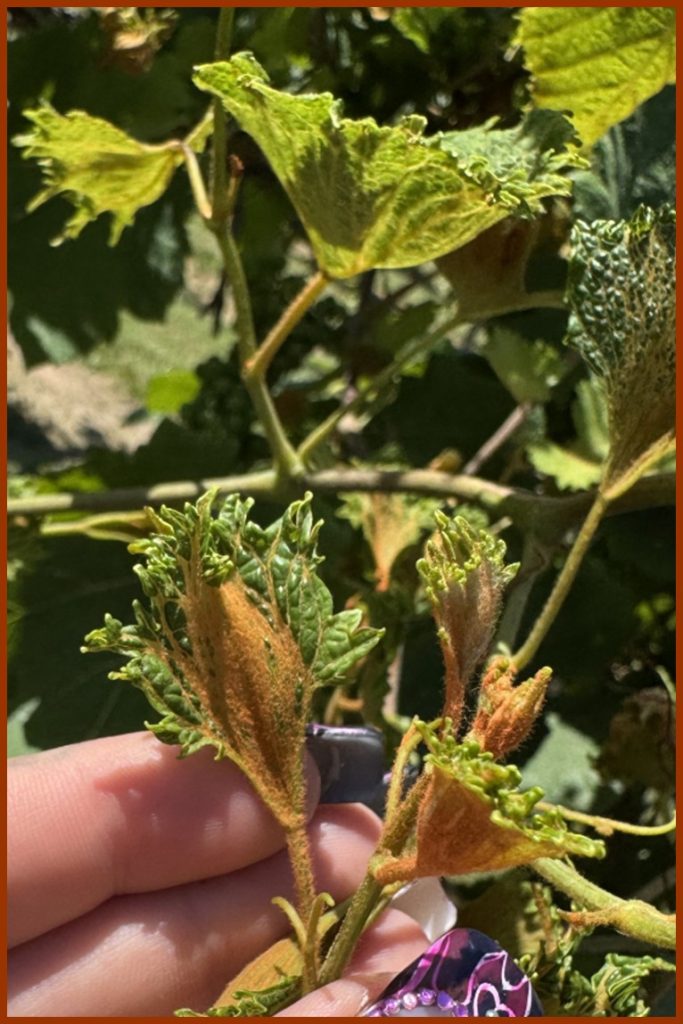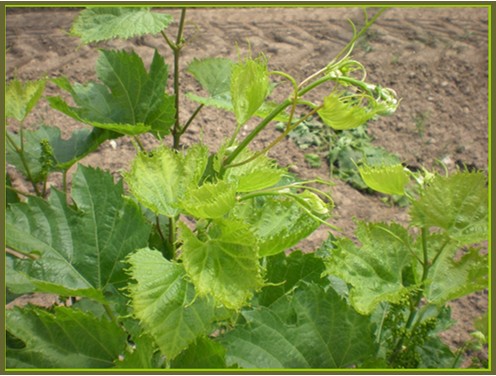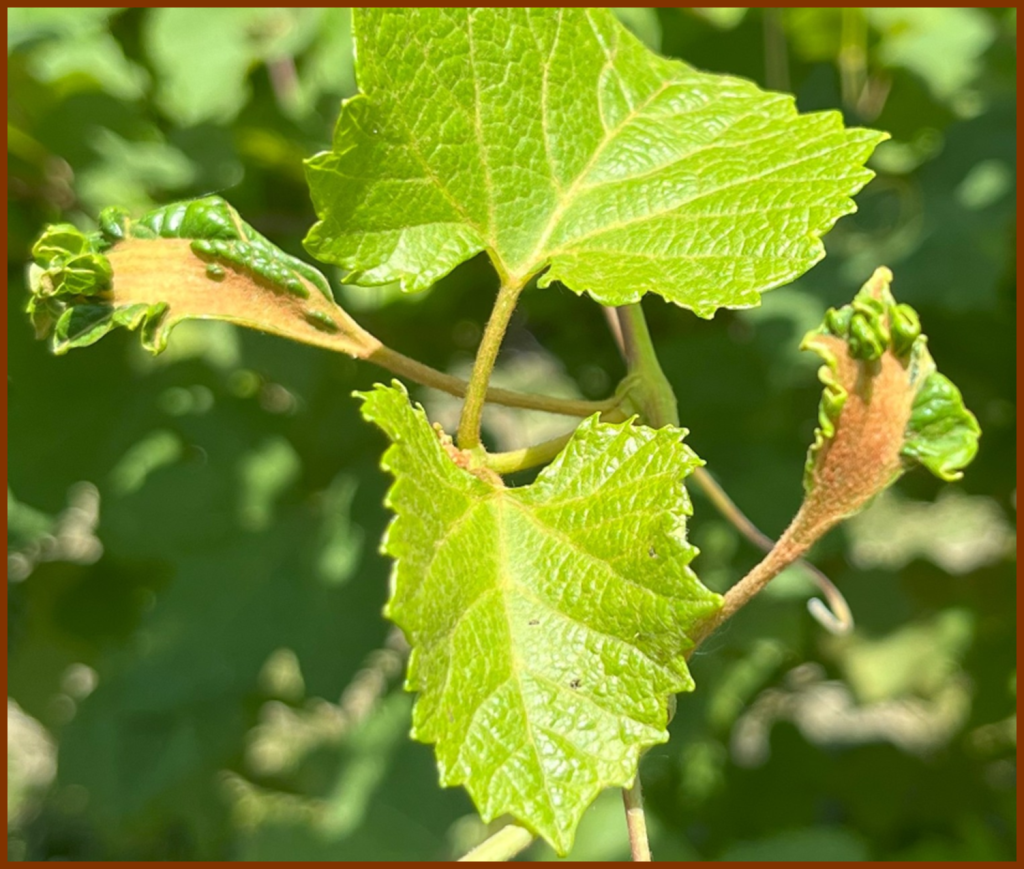Published on
Updated on

Viticulture News, Week of 7 July 2025
Columbia, MO
Contents:
- Herbicide drift injury is on the increase
- Herbicide drift: What to do?
- Cumulative Growing Degree Days for Seven Grape Growing Regions of Missouri from April 1 to July 7, 2025
Herbicide drift injury is on the increase
I don’t believe a week has passed since this growing season began when I have not had a report from a grape grower that has experienced herbicide drift injury. So far this week two more Missouri and one Kansas grape grower reported herbicide drift injury. The injury is the result of synthetic auxin herbicide drift. There are several synthetic auxin herbicide products and these are used in row crops, lawns/turf, and highway rights-of-way as well as other areas. A large percentage of these synthetic auxin herbicides are applied to row crops with the development of synthetic auxin herbicide resistant corn and soybeans.
I was expecting to see less herbicide drift injury to grapes this year with three over-the-top (post-emergent application) dicamba herbicide product registrations being vacated in 2024. These products, BASF’s Engenia, Bayer’s XtendiMax and Syngenta’s Tavium were not available to growers in 2025. However, dicamba resistant soybeans were available to plant. These dicamba resistant soybeans are only supposed to be sprayed with the herbicide products in which the registrations have been vacated. In other words, other formulations of dicamba are not supposed to be applied to these dicamba resistant soybeans. The label is the law. With some dicamba herbicide products not being available in 2025, why is grape injury increasing in 2025. The likely explanation is another synthetic auxin herbicide, 2,4-D.
Enlist corn and soybeans are resistant to 2,4-D, glyphosate (Roundup) and glufosinate (Liberty). The Enlist crops are supposed to be treated only with 2,4-D choline which has low volatility. In comparison, dicamba has greater propensity to volatilize and move off site compared to 2,4-D choline. However, grapevines are much more sensitive to 2,4-D compared to dicamba. My previous research showed that grapes are sensitive to 1/100 the field application rate of dicamba and 2,4-D. To put that in perspective, that is approximately 5 teaspoons of 2,4-D/acre and 4 teaspoons of dicamba/acre. Now you see why grapes are often considered the “Canary in the coal mine” for detecting synthetic auxin herbicides.

If you experience herbicide drift injury refer to Herbicide Drift: What to Do.
This provides information on:
- Steps you should take to document the damage
- Links to file a Pesticide incident report
- Contact information at the Bureau of Pesticide Control
- Proactive steps to protect your crop from herbicide drift
Herbicide Drift: What to do?
When your vines experience herbicide drift be responsive and follow a reasonable response plan but don’t forget about using the incident as means to implement a proactive prevention plan.
Herbicide drift is off-site movement and can result in non-target plant injury. Off-site movement of herbicides can occur by volatilization or physical drift.
Volatilization is the conversion from a liquid or solid state to a gas or vapor state after the herbicide has been applied to the intended site. The herbicide in the gas or vapor phase may then move off-site and is affected by air temperature, wind speed, and moisture. Herbicides with high vapor pressures are considerably more volatile than herbicides with low vapor pressures. As an example, ester formulations of 2,4-D have higher vapor pressure and tend to volatilize more than amine formulations. The volatility can increase during hot dry weather.
Physical drift is the off–site movement of herbicide droplets prior to deposition at the intended site. Both environmental conditions and application equipment setup can play a role in physical drift. Wind speeds over 10 mph coupled with high temperatures and low humidity can cause spray droplets to evaporate quickly before deposition. These smaller herbicide-laden water droplets can then move from the intended site of application. Although spray equipment set-up is important and includes; nozzle selection, spray pressure, and boom height, physical drift can often be avoided if applications are avoided during high winds, low humidity, and high temperatures.

Reasonable Response to Herbicide Drift
Action Steps
- Document the damage using pictures and record the date the damage was first noticed. Also record the number of grape vines damaged, age of vines, and cultivars damaged. In addition document the phenology of when the damage occurred. For example, 3-inch shoots, 10-inch shoots, immediate pre-bloom, bloom etc.
- Try to identify the potential source of herbicide drift and types of herbicide(s). Be neighborly and try to resolve the problem without accusations. Remember that there are many potential sources of herbicide drift, including custom pesticide applicators, home owners, lawn care professionals, golf course managers, highway crews, etc.
- Contact the Missouri Department of Agriculture if you want to formalize a complaint. ThePesticide Incident Reportshould be filed within 30-days of when the damage was alleged to have occurred.
- Bureau of Pesticide Control 573-751-5504
- Missouri Department of Agriculture Enforcement and Inspections
- Document the progression of the damage over time using pictures. Consider identifying 4 to 5 vines and identifying them with flagging tape and taking pictures on a weekly schedule. Try to take the pictures on the same day of the week to document the damage progressively.
- Document and record yield and continue to document damage the following season(s).
Auxiliary Step: For those that want to go the extra step and fully document what herbicide(s) may be causing the damage, the affected tissues can be screened for the presence of herbicides. Contact SGS Analytical Services for pricing and sample submission. If interested in this service be sure to collect a sample when symptoms first appear because over time the grape plant will metabolize the active ingredient into metabolites. I do not endorse this lab over any others.
Another Consideration. Also be aware that if a herbicide residue is found within a crop in which the product is not labelled that there is the potential that the crop may not be able to be harvested. For example, if 2,4-D resides are found within grape leaves that would be off label as 2,4-D is not labelled to be used in grapes. Even though the product was not applied but drifted onto the grape crop.
Proactive Prevention of Herbicide Drift
- Site selection is your best tool to avoid herbicide drift. Select a vineyard site that is not in close proximity to row-crop agriculture, or other areas where phenoxy herbicides are used regularly such as golf courses, right-of-ways, and housing subdivisions.
- Create awareness of your vineyard to neighbors and educate neighbors about the sensitivity of grape vines to phenoxy herbicides. Explain alternative practices that can reduce the potential of herbicide drift. For example, using 2,4-D amine instead of ester formulations of 2,4-D, applying phenoxy herbicides when the air temperature is below 80° F, using spray nozzles that increase droplet size such as air induction nozzles, applying pesticides when the wind speeds are 3 to 10 mph and the wind is not blowing towards the vineyard, and using appropriate sprayer boom height.
- Consider planting buffer zones of trees to limit drift into your vineyard. If planting trees for a buffer zone, do not plant trees that will limit cold air drainage.
- Register your vineyard on the Drift Watch website. This creates more awareness for your vineyard and also allows pesticide applicators to know the exact location. Many commercial applicators use the Drift Watch site to identify sensitive crop locations
Herbicides Causing Grape Injury
Grapevines are sensitive to a number of herbicides. Many grape growers are familiar with the damage caused by 2,4-D. The herbicide 2,4-D is classified as a phenoxy herbicide. There are a number of herbicides that can cause similar symptomology as 2,4-D on grapes. All of these herbicides are classified as auxin growth regulators (Table 1).
Table 1. Common auxin growth regulator herbicides that can cause injury to grape vines.
| Herbicide Class | Common name | Active ingredient | Trade name |
|---|---|---|---|
| Phenoxyacetic | 2,4-D | Dimethylamine salt of 2,4 -dichlorophenoxyacetic acid | 2,4-D |
| MCPA | Dimethylamine salt of 2- methyl-4- chlorophenoxyacetic acid | MCPA | |
| Benzoic Acids | dicamba | 3,6-dichloro- 2methoxybenzoic acid | Banvel, Clarity |
| Picilinic Acids (Pyridines) | picloram | 4-amino-3,5,6- trichloropicolinic acid | Tordon, Grazon1 |
| clopyralid | 3,6-dichloro-2- pyridinecarboxylic acid | Stinger, Transline | |
| triclopyr | 2,5,6-trichloro-2- pyridinyloxyacetic acid | Crossbow2, Garlon |
1 Grazon is a premix and also contains 2,4-D.
2Crossbow is a premix and also contains 2,4-D as a butoxyethyl ester.
Some of these herbicides are used in agricultural row-crops to control broadleaf weeds. However be aware that 2,4-D, MCPA, and dicamba are also available in pre- mixes to control many broadleaf weeds in lawns or turf. The picolinic acids and pyridines that includes products containing picloram, clopyralid or triclopyr are often used to control woody vegetation in ditches, fence lines, right-of-ways, and grass pastures. All the herbicides listed in Table 1 have the potential to volatize and lift off the intended target site after application.
Although the growth regulator herbicides are often reported as causing injury to grapes there are also a number of other herbicides that can cause herbicide injury to grapevines. Glyphosate the active ingredient in a number of herbicides (Roundup Ultra, Weathermax, Touchdown etc.) can cause substantial damage to grapevines if it comes in contact with green tissue.
The Weathermax label specifically states to keep the spray mixture off green grape tissues such as leaves, shoots, suckers, and green trunks. Glyphosate is a systemic herbicide and is readily translocated to growing points in the roots and shoots causing cell death. A number of glyphosate containing products are used both in row-crop agriculture, right-of-ways, and by homeowners. Although glyphosate does not have the propensity to volatilize like the growth regulator herbicides, the spray mixture can move off-target if not applied in accordance with the label.
Not sure what herbicide may be causing the damage? Review this herbicide mode of action chart to narrow the possibilities.
What you should expect if you file a pesticide incident report
- You will be contacted by a pesticide investigator
- The investigator will likely visit your vineyard to document damage and take tissue samples
- The investigator may request the following:
- Your pesticide records/spray application log
- To view your pesticide storage area
- If you have employees outside of your immediate family be sure you are in compliance with worker protection standards
- An official report of the pesticide incident often takes 1 year

Cumulative Growing Degree Days for the Seven Grape Growing Regions of Missouri from April 1 to July 7, 2025.

1Growing degree days at base 50 from April 1 to July 7, 2025. Data compiled from U2U Decision Support Tools – Corn GDD
To determine the number of growing degree days accumulated in your area since April 1. Use this tool.
Please scout your vineyards on a regularly scheduled basis in an effort to manage problem pests. This report contains information on scouting reports from specific locations and may not reflect pest problems in your vineyard. If you would like more information on IPM in grapes, please contact Dean Volenberg at 573-473-0374 or volenbergd@missouri.edu